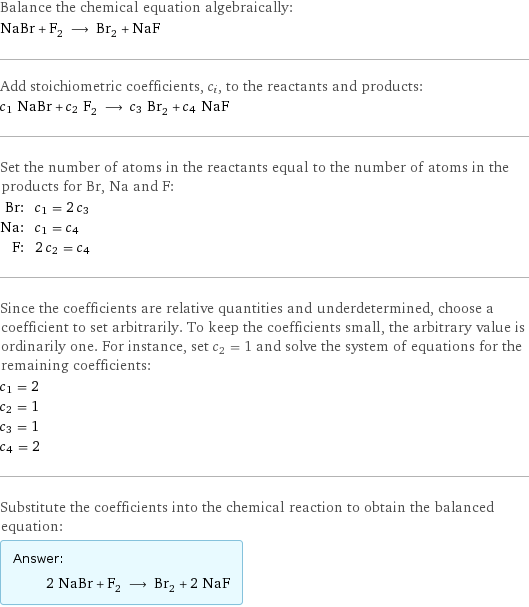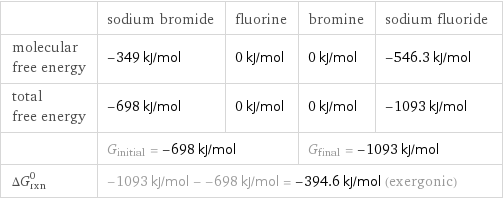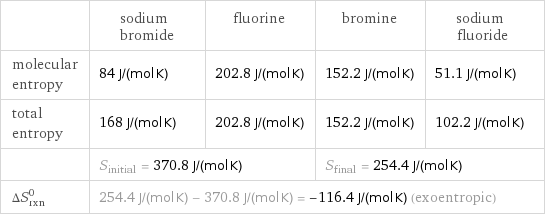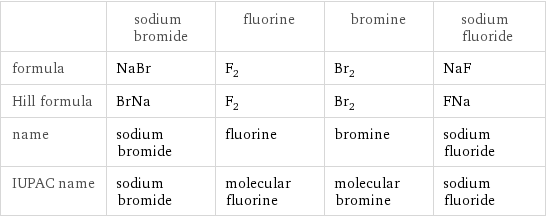Input interpretation

NaBr sodium bromide + F_2 fluorine ⟶ Br_2 bromine + NaF sodium fluoride
Balanced equation

Balance the chemical equation algebraically: NaBr + F_2 ⟶ Br_2 + NaF Add stoichiometric coefficients, c_i, to the reactants and products: c_1 NaBr + c_2 F_2 ⟶ c_3 Br_2 + c_4 NaF Set the number of atoms in the reactants equal to the number of atoms in the products for Br, Na and F: Br: | c_1 = 2 c_3 Na: | c_1 = c_4 F: | 2 c_2 = c_4 Since the coefficients are relative quantities and underdetermined, choose a coefficient to set arbitrarily. To keep the coefficients small, the arbitrary value is ordinarily one. For instance, set c_2 = 1 and solve the system of equations for the remaining coefficients: c_1 = 2 c_2 = 1 c_3 = 1 c_4 = 2 Substitute the coefficients into the chemical reaction to obtain the balanced equation: Answer: | | 2 NaBr + F_2 ⟶ Br_2 + 2 NaF
Structures

+ ⟶ +
Names

sodium bromide + fluorine ⟶ bromine + sodium fluoride
Reaction thermodynamics
Enthalpy

| sodium bromide | fluorine | bromine | sodium fluoride molecular enthalpy | -361.1 kJ/mol | 0 kJ/mol | 0 kJ/mol | -576.6 kJ/mol total enthalpy | -722.2 kJ/mol | 0 kJ/mol | 0 kJ/mol | -1153 kJ/mol | H_initial = -722.2 kJ/mol | | H_final = -1153 kJ/mol | ΔH_rxn^0 | -1153 kJ/mol - -722.2 kJ/mol = -431 kJ/mol (exothermic) | | |
Gibbs free energy

| sodium bromide | fluorine | bromine | sodium fluoride molecular free energy | -349 kJ/mol | 0 kJ/mol | 0 kJ/mol | -546.3 kJ/mol total free energy | -698 kJ/mol | 0 kJ/mol | 0 kJ/mol | -1093 kJ/mol | G_initial = -698 kJ/mol | | G_final = -1093 kJ/mol | ΔG_rxn^0 | -1093 kJ/mol - -698 kJ/mol = -394.6 kJ/mol (exergonic) | | |
Entropy

| sodium bromide | fluorine | bromine | sodium fluoride molecular entropy | 84 J/(mol K) | 202.8 J/(mol K) | 152.2 J/(mol K) | 51.1 J/(mol K) total entropy | 168 J/(mol K) | 202.8 J/(mol K) | 152.2 J/(mol K) | 102.2 J/(mol K) | S_initial = 370.8 J/(mol K) | | S_final = 254.4 J/(mol K) | ΔS_rxn^0 | 254.4 J/(mol K) - 370.8 J/(mol K) = -116.4 J/(mol K) (exoentropic) | | |
Equilibrium constant
![Construct the equilibrium constant, K, expression for: NaBr + F_2 ⟶ Br_2 + NaF Plan: • Balance the chemical equation. • Determine the stoichiometric numbers. • Assemble the activity expression for each chemical species. • Use the activity expressions to build the equilibrium constant expression. Write the balanced chemical equation: 2 NaBr + F_2 ⟶ Br_2 + 2 NaF Assign stoichiometric numbers, ν_i, using the stoichiometric coefficients, c_i, from the balanced chemical equation in the following manner: ν_i = -c_i for reactants and ν_i = c_i for products: chemical species | c_i | ν_i NaBr | 2 | -2 F_2 | 1 | -1 Br_2 | 1 | 1 NaF | 2 | 2 Assemble the activity expressions accounting for the state of matter and ν_i: chemical species | c_i | ν_i | activity expression NaBr | 2 | -2 | ([NaBr])^(-2) F_2 | 1 | -1 | ([F2])^(-1) Br_2 | 1 | 1 | [Br2] NaF | 2 | 2 | ([NaF])^2 The equilibrium constant symbol in the concentration basis is: K_c Mulitply the activity expressions to arrive at the K_c expression: Answer: | | K_c = ([NaBr])^(-2) ([F2])^(-1) [Br2] ([NaF])^2 = ([Br2] ([NaF])^2)/(([NaBr])^2 [F2])](../image_source/64c5a84ea462f9729049a9712c2a0b98.png)
Construct the equilibrium constant, K, expression for: NaBr + F_2 ⟶ Br_2 + NaF Plan: • Balance the chemical equation. • Determine the stoichiometric numbers. • Assemble the activity expression for each chemical species. • Use the activity expressions to build the equilibrium constant expression. Write the balanced chemical equation: 2 NaBr + F_2 ⟶ Br_2 + 2 NaF Assign stoichiometric numbers, ν_i, using the stoichiometric coefficients, c_i, from the balanced chemical equation in the following manner: ν_i = -c_i for reactants and ν_i = c_i for products: chemical species | c_i | ν_i NaBr | 2 | -2 F_2 | 1 | -1 Br_2 | 1 | 1 NaF | 2 | 2 Assemble the activity expressions accounting for the state of matter and ν_i: chemical species | c_i | ν_i | activity expression NaBr | 2 | -2 | ([NaBr])^(-2) F_2 | 1 | -1 | ([F2])^(-1) Br_2 | 1 | 1 | [Br2] NaF | 2 | 2 | ([NaF])^2 The equilibrium constant symbol in the concentration basis is: K_c Mulitply the activity expressions to arrive at the K_c expression: Answer: | | K_c = ([NaBr])^(-2) ([F2])^(-1) [Br2] ([NaF])^2 = ([Br2] ([NaF])^2)/(([NaBr])^2 [F2])
Rate of reaction
![Construct the rate of reaction expression for: NaBr + F_2 ⟶ Br_2 + NaF Plan: • Balance the chemical equation. • Determine the stoichiometric numbers. • Assemble the rate term for each chemical species. • Write the rate of reaction expression. Write the balanced chemical equation: 2 NaBr + F_2 ⟶ Br_2 + 2 NaF Assign stoichiometric numbers, ν_i, using the stoichiometric coefficients, c_i, from the balanced chemical equation in the following manner: ν_i = -c_i for reactants and ν_i = c_i for products: chemical species | c_i | ν_i NaBr | 2 | -2 F_2 | 1 | -1 Br_2 | 1 | 1 NaF | 2 | 2 The rate term for each chemical species, B_i, is 1/ν_i(Δ[B_i])/(Δt) where [B_i] is the amount concentration and t is time: chemical species | c_i | ν_i | rate term NaBr | 2 | -2 | -1/2 (Δ[NaBr])/(Δt) F_2 | 1 | -1 | -(Δ[F2])/(Δt) Br_2 | 1 | 1 | (Δ[Br2])/(Δt) NaF | 2 | 2 | 1/2 (Δ[NaF])/(Δt) (for infinitesimal rate of change, replace Δ with d) Set the rate terms equal to each other to arrive at the rate expression: Answer: | | rate = -1/2 (Δ[NaBr])/(Δt) = -(Δ[F2])/(Δt) = (Δ[Br2])/(Δt) = 1/2 (Δ[NaF])/(Δt) (assuming constant volume and no accumulation of intermediates or side products)](../image_source/4cb9a8c1248d221ae4d21dba63ec082d.png)
Construct the rate of reaction expression for: NaBr + F_2 ⟶ Br_2 + NaF Plan: • Balance the chemical equation. • Determine the stoichiometric numbers. • Assemble the rate term for each chemical species. • Write the rate of reaction expression. Write the balanced chemical equation: 2 NaBr + F_2 ⟶ Br_2 + 2 NaF Assign stoichiometric numbers, ν_i, using the stoichiometric coefficients, c_i, from the balanced chemical equation in the following manner: ν_i = -c_i for reactants and ν_i = c_i for products: chemical species | c_i | ν_i NaBr | 2 | -2 F_2 | 1 | -1 Br_2 | 1 | 1 NaF | 2 | 2 The rate term for each chemical species, B_i, is 1/ν_i(Δ[B_i])/(Δt) where [B_i] is the amount concentration and t is time: chemical species | c_i | ν_i | rate term NaBr | 2 | -2 | -1/2 (Δ[NaBr])/(Δt) F_2 | 1 | -1 | -(Δ[F2])/(Δt) Br_2 | 1 | 1 | (Δ[Br2])/(Δt) NaF | 2 | 2 | 1/2 (Δ[NaF])/(Δt) (for infinitesimal rate of change, replace Δ with d) Set the rate terms equal to each other to arrive at the rate expression: Answer: | | rate = -1/2 (Δ[NaBr])/(Δt) = -(Δ[F2])/(Δt) = (Δ[Br2])/(Δt) = 1/2 (Δ[NaF])/(Δt) (assuming constant volume and no accumulation of intermediates or side products)
Chemical names and formulas

| sodium bromide | fluorine | bromine | sodium fluoride formula | NaBr | F_2 | Br_2 | NaF Hill formula | BrNa | F_2 | Br_2 | FNa name | sodium bromide | fluorine | bromine | sodium fluoride IUPAC name | sodium bromide | molecular fluorine | molecular bromine | sodium fluoride
Substance properties

| sodium bromide | fluorine | bromine | sodium fluoride molar mass | 102.89 g/mol | 37.996806326 g/mol | 159.81 g/mol | 41.98817244 g/mol phase | solid (at STP) | gas (at STP) | liquid (at STP) | solid (at STP) melting point | 755 °C | -219.6 °C | -7.2 °C | 993 °C boiling point | 1396 °C | -188.12 °C | 58.8 °C | 1700 °C density | 3.2 g/cm^3 | 0.001696 g/cm^3 (at 0 °C) | 3.119 g/cm^3 | 2.558 g/cm^3 solubility in water | soluble | reacts | insoluble | surface tension | | | 0.0409 N/m | dynamic viscosity | | 2.344×10^-5 Pa s (at 25 °C) | 9.44×10^-4 Pa s (at 25 °C) | 0.00105 Pa s (at 1160 °C) odor | | | | odorless
Units
